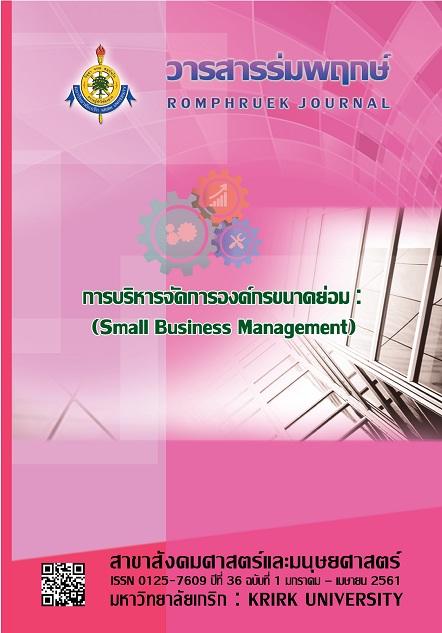Bojjhanga Mindfulness : an intrapersonal - communication of HIV/AIDS Infected Individuals Spiritual Therapy to “Stigmatise” Discourse
Main Article Content
Abstract
Bojjhanga Mindfulness is an intrapersonal communication that is effective in treating HIV/AIDS Infected Individuals due to Stigmatise Discourse. When persons realize that they infected, they can immediately be contemplated a mindfulness and always continue to maintain Bojjhanga mindfulness without the need of using antiviral drugs. Using Bojjhanga Mindfulness to encourage HIV/AIDS Infected Individuals due to Stigmatise Discourse with intrapersonal communication is the supporting a cure by using antiviral drugs, modern medical profession, more effectively. It’s a direct benefaction for HIV/AIDS Infected Individuals. Furthermore, there are very few researches in communication arts about a cure for HIV/AIDS Infected Individuals by using an intrapersonal communication and other communication levels, i.e., interpersonal communication, group communication, and community communication. So, it’s necessary to study in the form of creating theories from the field research (grounded theory) to continue formulating knowledge.
Article Details
Every article published in the Romphruek Journal of the Humanities and Social Sciences is the opinion and point of view of the authors. Thery're not the viewpoint of Krirk University or the editored department. Any part or all of the articles for pablication must be clearly cited.
References
จันทร์สุดา สุวรรณจันดี. (2554). เรื่องเล่าของฉันในวันที่อยู่กับเอชไอวี. กรุงเทพฯ : โรงพิมพ์ ส.ไพบูลย์การพิมพ์.
ไชยรัตน์ เจริญสินโอฬาร. (2549). วาทกรรมการพัฒนา อำนาจ ความรู้ ความจริง เอกลักษณ์ และความเป็นอื่น. กรุงเทพฯ : วิภาษา.
บุษรา กระแสบุตร. (2554). คุณภาพชีวิตของผู้ติดเชื้อเอชไอวี/เอดส์ที่ได้รับการรักษาด้วยยาต้านไวรัสแบบ
สามชนิดพร้อมกัน (HAART Treatment). คณะสังคมศาสตร์การแพทย์และสาธารณสุข มหาวิทยาลัยมหิดล, กรุงเทพฯ.
ป. อ. ปยุตฺโต. (2552). พุทธธรรม. กรุงเทพฯ : สหธรรมิก.
อาภัสรา จันสุวรรณ. (2535). ความวิตกกังวลอันเกิดจากข้อมูลข่าวสารการรณรงค์เรื่องโรคเอดส์ผ่านสื่อมวลชนช่วงปี พ.ศ.2531 – 2534 กรณีศึกษาในทัศนะแบบองค์รวม. คณะนิเทศศาสตร์ จุฬาลงกรณ์มหาวิทยาลัย, กรุงเทพฯ.
Cassell, E. J. (1976). The Healer art : A New Approach to the Doctor-Patient Relationship. New York : Lippincott.
เขต, ผู้ติดเชื้อเอชไอวี/เอดส์. สัมภาษณ์, 11 พฤษภาคม 2555.
จุติ รัตนศิริ, แพทย์ประจำโรงพยาบาลเซ็นทรัล. สัมภาษณ์, 6 พฤษภาคม 2555.
นี, ผู้ติดเชื้อเอชไอวี/เอดส์. สัมภาษณ์, 2 สิงหาคม 2555.
นุชนารถ, พยาบาลวิชาชีพชำนาญการที่ทำหน้าที่พยาบาลผู้ติดเชื้อเอชไอวี/เอดส์ในวัดพระบาทน้ำพุ. สัมภาษณ์, 7 มิถุนายน 2555.
บัว, ผู้ติดเชื้อเอชไอวี/เอดส์. สัมภาษณ์, 15 กันยายน 2555.
ป่อง, ผู้ติดเชื้อเอชไอวี/เอดส์. สัมภาษณ์, 19 กุมภาพันธ์ 2555.
ป้อม, ผู้ติดเชื้อเอชไอวี/เอดส์. สัมภาษณ์, 2 ธันวาคม 2555.
มิตร, ผู้ติดเชื้อเอชไอวี/เอดส์. สัมภาษณ์, 7 กุมภาพันธ์ 2555.
สมใจ, ผู้ติดเชื้อเอชไอวี/เอดส์. สัมภาษณ์, 2 กันยายน, 2555.
สุรภี ศักดิ์ไพบูลย์, พยาบาลวิชาชีพชำนาญการประจำโรงพยาบาลสมเด็จพระนารายณ์มหาราช. สัมภาษณ์, 9 กันยายน 2555.
หนวด, ผู้ติดเชื้อเอชไอวี/เอดส์. สัมภาษณ์, 31 มีนาคม 2555.
หลง,ผู้ติดเชื้อเอชไอวี/เอดส์. สัมภาษณ์, 11 มิถุนายน 2555.


